View in other NatureServe Network Field Guides
NatureServe
Montana
Utah
Wyoming
Idaho
Wisconsin
British Columbia
South Carolina
Yukon
California
New York
Migratory Grasshopper - Melanoplus sanguinipes
General Description
The following is taken from Hebard(1928), Helfer (1971), Vickery and Kevan (1985), Pfadt (2002), Capinera et al. (2004), Capinera and Sechrist (1982), Schell et al. (2005), Brust et al. (2008),
and Scott (2010). This medium sized grasshopper is dark grayish-brown tinged with reddish dorsally and yellowish ventrally. The wings (tegmina) are long, extending beyond the abdomen tip and spotted centrally. The hind femur usually has two oblique dark bands on the upper and outer faces. The hind tibia is usually red, but can vary to blue, buff, or yellowish.
Phenology
The Migratory Grasshopper is an early hatching species. Nymphs occur in mid-May to mid-June, and adults are found from mid-June through October, sometimes into early November (Capinera et al. 2004, Capinera and Sechrist 1982, Pfadt 2002, Schellet al. 2005, and Scott 2010).
Diagnostic Characteristics
The following comes from Hebard (1928), Helfer (1971), Vickery and Kevan (1985), Pfadt (2002), Capinera et al. (2004), Capinera and Sechrist (1982), Schell et al. (2005), Brust et al. (2008), and Scott (2010). The male body length is 18 to 26 mm, and females 20 to 29 mm. Ventrally, there is a distinctive bump or lobe at the center of the thorax between the front and middle legs. The subgenital plate of the male genitalia is strongly notched at its apex.
Can be confused with
Bruner's Spur-throat, (
M. bruneri). Examine male genitalia for comparisons and positive identification. Also, similar to the now-extinct
Rocky Mountain Grasshopper, (
M. spretus).
Species Range
Montana Range
Range Descriptions
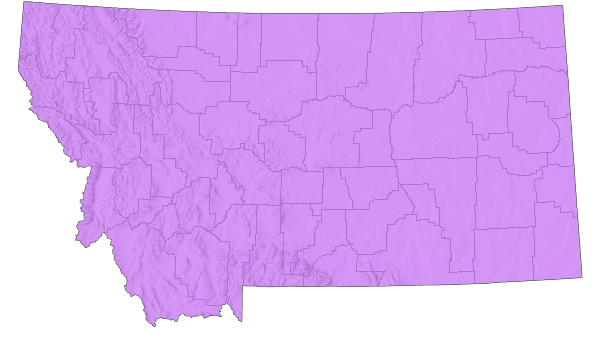
 Native
Native
Range Comments
The Migratory Grasshopper has a broader geographic range than any other species of Melanoplus. Found throughout the United States, all Canadian provinces, and into southern Alaska. In Montana, it is common and abundant in all 56 counties (Capinera and Sechrist 1982, Capinera et al. 2004, Pfadt 2002, and Scott 2010).
Observations in Montana Natural Heritage Program Database
Number of Observations: 79
(Click on the following maps and charts to see full sized version)
Map Help and Descriptions
Relative Density
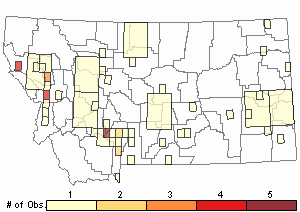
Recency
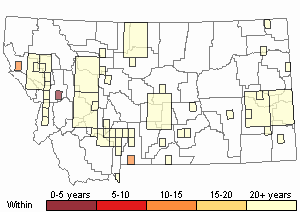

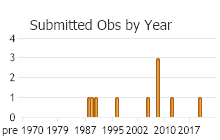
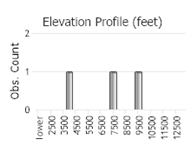 (Observations spanning multiple months or years are excluded from time charts)
(Observations spanning multiple months or years are excluded from time charts)
Habitat
The following comes from Capinera and Sechrist 1982, Capinera et al. 2004, Pfadt 2002, and Vickery and Kevan 1985. Inhabits a wide variety of habitats from sea level to mountain elevations up to 8800 feet. Common in grasslands, meadows, and weedy areas. It has adapted well to western agricultural lands. The introduction of weeds, plowing of prairies and overgrazing of rangelands have created especially favorable habitats. Plowing of sandy soils resulting in wind-blown drifts have furnished favorable egg-laying or oviposition sites.
Food Habits
The following comes from Vickery and Kevan 1985, Pfadt 2002, Capinera and Sechrist 1982, Capinera et al. 2004, and Schell et al. 2005. The Migratory Grasshopper is an omnivorous species with a preference toward a large variety of forbs, grasses, wheat, barley, and other crops. It also scavenges upon ground litter, dead insects, and dried manure. During outbreaks this species consumes just about all plants including trees and ornamentals, and small grains at all growth stages.
Reproductive Characteristics
Taken from Capinera and Sechrist 1982, Capinera et al. 2004, and Pfadt 2002. At high population densities, a behavioral change occurs in the Migratory Grasshopper wherein they become more gregarious and begin moving as a group. Bands of the older nymphs, third to sixth instars, may migrate as far as 5 to 10 miles, travelling at a rate of 0.1 mile per hour. Adults are highly migratory. Swarming occurs on clear days when temperatures approach 80 degrees F with gentle, intermittent winds. The grasshoppers usually begin flights in late morning, fly during mid-day, and alight in the afternoon to feed and rest. They fly at about 10 to 12 miles per hour, covering about 30 or more miles per day. Flights have been designated as “low” (<25 feet) or “high” (>25 feet), although research programs have recorded “high flights” up to >1000 feet.
Management
Considered one of the most destructive grasshoppers to grasslands, rangelands, and can become a serious agricultural and suburban pest. It is generally more destructive in dryland areas than in irrigated areas (Capinera and Sechrist 1982, Capinera et al. 2004, Pfadt 2002, and Schell et al. 2005).
Stewardship Responsibility
References
- Literature Cited AboveLegend:
 View Online Publication
View Online Publication Brust, M.L., W.W. Hoback, and R.J. Wright. 2008. A Synopsis of Nebraska Grasshopper Distributions. Journal of the Kansas Entomological Society 81(3):208-255.
Brust, M.L., W.W. Hoback, and R.J. Wright. 2008. A Synopsis of Nebraska Grasshopper Distributions. Journal of the Kansas Entomological Society 81(3):208-255. Capinera, J.L. and T.S. Sechrist. 1982. Grasshoppers of Colorado: Identification, Biology, and Management. Fort Collins, CO: Colorado State University Experiment Station, Bulletin 584S. 161 p.
Capinera, J.L. and T.S. Sechrist. 1982. Grasshoppers of Colorado: Identification, Biology, and Management. Fort Collins, CO: Colorado State University Experiment Station, Bulletin 584S. 161 p. Capinera, J.L., R.D. Scott, and T.J. Walker. 2004. Field Guide to Grasshoppers, Katydids, and Crickets of the United States. Ithaca, NY. Cornell University Press.
Capinera, J.L., R.D. Scott, and T.J. Walker. 2004. Field Guide to Grasshoppers, Katydids, and Crickets of the United States. Ithaca, NY. Cornell University Press. Hebard, M. 1928. The Orthoptera of Montana. Proceedings of the Academy of Natural Sciences of Philadelphia, Vol. 80:211-306.
Hebard, M. 1928. The Orthoptera of Montana. Proceedings of the Academy of Natural Sciences of Philadelphia, Vol. 80:211-306. Helfer, J.R. 1971. How to Know the Grasshoppers, Crickets, Cockroaches, and Their Allies. Revised edition (out of print), Mineola, NY: Dover Publications.
Helfer, J.R. 1971. How to Know the Grasshoppers, Crickets, Cockroaches, and Their Allies. Revised edition (out of print), Mineola, NY: Dover Publications. Pfadt, R.E. 2002. Field Guide to Common Western Grasshoppers, 3rd edition. Laramie, WY: Wyoming Agricultural Experiment Station, Bulletin 912, modified by S. Schell and S. Schell for electronic publication. Accessed 19 February 2020. http://www.uwyo.edu/entomology/grasshoppers/field-guide/index.html#fieldguidetoc
Pfadt, R.E. 2002. Field Guide to Common Western Grasshoppers, 3rd edition. Laramie, WY: Wyoming Agricultural Experiment Station, Bulletin 912, modified by S. Schell and S. Schell for electronic publication. Accessed 19 February 2020. http://www.uwyo.edu/entomology/grasshoppers/field-guide/index.html#fieldguidetoc Schell, S.P., A.V. Latchininsky, and B.A. Shambaugh. 2005. Common Wyoming Pest Grasshoppers. 2nd Edition B-1161.Laramie, WY: University of Wyoming Cooperative Extension Service and Department of Renewable Resources. 76 p.
Schell, S.P., A.V. Latchininsky, and B.A. Shambaugh. 2005. Common Wyoming Pest Grasshoppers. 2nd Edition B-1161.Laramie, WY: University of Wyoming Cooperative Extension Service and Department of Renewable Resources. 76 p. Scott, R.D. 2010. Montana Grasshoppers, Katydids, and Crickets A Pictorial Field Guide to the Orthoptera. MagpieMTGraphics, Billings, MT.
Scott, R.D. 2010. Montana Grasshoppers, Katydids, and Crickets A Pictorial Field Guide to the Orthoptera. MagpieMTGraphics, Billings, MT. Vickery, V. R. and D. K. M. Kevan. 1985. The grasshopper, crickets, and related insects of Canada and adjacent regions. Biosystematics Research Institute, Ottawa, Ontario. Publication Number 1777. 918 pp.
Vickery, V. R. and D. K. M. Kevan. 1985. The grasshopper, crickets, and related insects of Canada and adjacent regions. Biosystematics Research Institute, Ottawa, Ontario. Publication Number 1777. 918 pp.
- Additional ReferencesLegend:
 View Online Publication
View Online Publication
Do you know of a citation we're missing? Anderson, N.L. 1962. Grasshopper-vegetation relationships on Montana grasslands. Ph.D Dissertation. Bozeman, Montana: Montana State University. 73 p.
Anderson, N.L. 1962. Grasshopper-vegetation relationships on Montana grasslands. Ph.D Dissertation. Bozeman, Montana: Montana State University. 73 p. Belovsky, G.E. and J.B. Slade. 1995. Dynamics of two Montana grasshopper populations: Relationships among weather, food abundance and intraspecific competition. Oecologia. 101(3):383-396.
Belovsky, G.E. and J.B. Slade. 1995. Dynamics of two Montana grasshopper populations: Relationships among weather, food abundance and intraspecific competition. Oecologia. 101(3):383-396. Bland, R.G. 2003. The Orthoptera of Michigan—Biology, Keys, and Descriptions of Grasshoppers, Katydids, and Crickets. East Lansing, MI: Michigan State University Extension, Bulletin E-2815. 221 p.
Bland, R.G. 2003. The Orthoptera of Michigan—Biology, Keys, and Descriptions of Grasshoppers, Katydids, and Crickets. East Lansing, MI: Michigan State University Extension, Bulletin E-2815. 221 p. De Smet-Moens, H. 1982. The insect fauna of Canada Thistle Cirsium arvense (L.) Scop in southern Montana. M.Sc. Thesis. Bozeman, MT: Montana State University. 51 p.
De Smet-Moens, H. 1982. The insect fauna of Canada Thistle Cirsium arvense (L.) Scop in southern Montana. M.Sc. Thesis. Bozeman, MT: Montana State University. 51 p. Gillespie, R.L.1992. Dynamics of grasshoppers (Orthoptera: Acrididae) at a rangeland-crop interference. Ph.D. Bozeman, MT: Montana State University. 111 p.
Gillespie, R.L.1992. Dynamics of grasshoppers (Orthoptera: Acrididae) at a rangeland-crop interference. Ph.D. Bozeman, MT: Montana State University. 111 p. Henry, J.E. 1969. Protozoan and viral pathogens of grasshoppers. Ph.D. Dissertation. Bozeman, MT: Montana State University. 153 p.
Henry, J.E. 1969. Protozoan and viral pathogens of grasshoppers. Ph.D. Dissertation. Bozeman, MT: Montana State University. 153 p. Kirk, K. and C.R. Bomar. 2005. Guide to the grasshoppers of Wisconsin. Madison, WI: Wisconsin Department of Natural Resources, Bureau of Integrated Science Services PUB-SS-1008. 154 p.
Kirk, K. and C.R. Bomar. 2005. Guide to the grasshoppers of Wisconsin. Madison, WI: Wisconsin Department of Natural Resources, Bureau of Integrated Science Services PUB-SS-1008. 154 p. Kreasky, J.B. 1960. Studies on a growth factor in lettuce, Lactuca sativa var. romana Hort., required by the grasshoppers Melanoplus bilituratus (Wlk.) and M. bivittatus (Say). Ph.D. Dissertation. Bozeman, Montana: Montana State University. 61 p.
Kreasky, J.B. 1960. Studies on a growth factor in lettuce, Lactuca sativa var. romana Hort., required by the grasshoppers Melanoplus bilituratus (Wlk.) and M. bivittatus (Say). Ph.D. Dissertation. Bozeman, Montana: Montana State University. 61 p. Larson, D.P. 1996. Evaluation of sweep sampling as a method for determining grasshopper community composition on rangeland. M.Sc. Thesis. Bozeman, MT: Montana State University. 92 p.
Larson, D.P. 1996. Evaluation of sweep sampling as a method for determining grasshopper community composition on rangeland. M.Sc. Thesis. Bozeman, MT: Montana State University. 92 p. Rolston, M.G. 1997. The short term dynamics of behavioral thermoregulation of nymphs of the migratory grasshopper, Melanoplus sanguinipes. M. Sc. Thesis. Bozeman, MT: Montana State University. 98 p.
Rolston, M.G. 1997. The short term dynamics of behavioral thermoregulation of nymphs of the migratory grasshopper, Melanoplus sanguinipes. M. Sc. Thesis. Bozeman, MT: Montana State University. 98 p. Sater, S. 2022. The insects of Sevenmile Creek, a pictorial guide to their diversity and ecology. Undergraduate Thesis. Helena, MT: Carroll College. 242 p.
Sater, S. 2022. The insects of Sevenmile Creek, a pictorial guide to their diversity and ecology. Undergraduate Thesis. Helena, MT: Carroll College. 242 p. Skinner, K.F. 1995. Plant and grasshopper community composition: indicators & interactions across three spatial scales. M.Sc. Thesis. Bozeman, MT: Montana State University. 144 p.
Skinner, K.F. 1995. Plant and grasshopper community composition: indicators & interactions across three spatial scales. M.Sc. Thesis. Bozeman, MT: Montana State University. 144 p. Tharp, C. I. 1998. Laboratory and field evaluations of imidacloprid against the Migratory Grasshopper, Melanoplus sanguinipes (F.), and the Cereal Leaf Beetle, Oulema melanopus (L.), on small grain. M. Sc. Thesis. Bozeman, MT: Montana State University. 82 p.
Tharp, C. I. 1998. Laboratory and field evaluations of imidacloprid against the Migratory Grasshopper, Melanoplus sanguinipes (F.), and the Cereal Leaf Beetle, Oulema melanopus (L.), on small grain. M. Sc. Thesis. Bozeman, MT: Montana State University. 82 p. Van Horn, S.N. 1963. The embryogenesis and embryonic variability of Aulocara elliotto Thomas (Acrididae Orthoptera). Ph.D. Dissertation. Bozeman, MT: Montana State University. 172 p.
Van Horn, S.N. 1963. The embryogenesis and embryonic variability of Aulocara elliotto Thomas (Acrididae Orthoptera). Ph.D. Dissertation. Bozeman, MT: Montana State University. 172 p. Wachter, D.H. 1995. The ecology of selected grasshopper species along an elevational gradient. M.Sc. Thesis. Bozeman, Montana: Montana State University. 59 p.
Wachter, D.H. 1995. The ecology of selected grasshopper species along an elevational gradient. M.Sc. Thesis. Bozeman, Montana: Montana State University. 59 p.
- Web Search Engines for Articles on "Migratory Grasshopper"
- Additional Sources of Information Related to "Insects"





